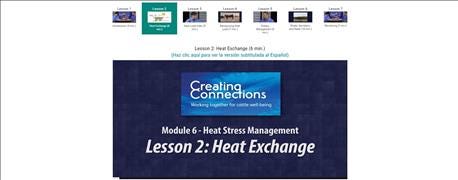July 13, 2016

Merck Animal Health, in partnership with the Beef Cattle Institute and Production Animal Consultation (PAC), just released the sixth module in the CreatingConnections educational series, this time on heat-stress management.
The CreatingConnections series features industry experts sharing unique insights and proven techniques to help ensure low-stress cattle handling.
This heat-stress module, available at www.creatingconnections.info, explains the stress of heat load on cattle, as well as heat stress management practices and their significance in maintaining animals’ well-being.

Marck provides several great training modules in its CreatingConnections videos. The newest one is on heat-stress management.
This module includes seven videos ranging from four to nine minutes in length. It is focused on feedlot situations, but heat stress certainly happens outside feedlots.
Grant Crawford, technical services manager for Merck Animal Health, says one of the lessons from the new video module is to watch weather forecasts, be knowledgeable about what factors increase heat stress, and plan ahead for ways to minimize the stress.
Crawford also noted it’s important to understand that heat load is about more than just the temperature on the thermometer. It also involves humidity, wind and solar radiation.
Kevin Sullivan, a partner in PAC, says beef producers should keep these five things in mind when working to manage heat stress.
1. Use shade, air movement, water and feedlot design to help reduce heat load. Extra water tanks should be on hand, if needed.
2. Keep the perimeter of feedlot pens clean from standing water or weeds as these may attract flies, further exacerbating stress associated with heat.
3. Sprinklers can be very useful, but feeders must ensure that they cover enough pen space, or cattle will crowd under the sprinkler. Sprinkling should be completed by early-to-mid morning. Otherwise, it will contribute to increased humidity in the pens and will be of very little benefit.
4. If it appears that heat stress days are imminent, feed deliveries should be static and possibly decreased to reduce the amount of feed wastage. A larger portion of the feed delivery should be fed in the afternoon rather than morning to allow cattle to carry the heat load associated with feed intake into the evening rather than the day. This is because most of the heat in their bodies comes from metabolic functions, including digestion.
5. Avoid working cattle during temperature extremes; handle them early in the morning.
You May Also Like




